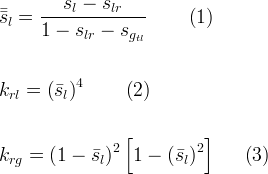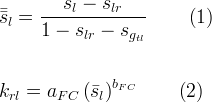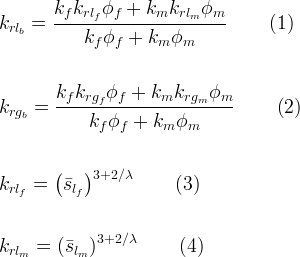Directional Aqueous Relative Permeability Options (GT)
Directional/Anisotropic Relative Permeability Options
Sub-Options
Effective Aqueous Liquid Saturation
Mobile saturations are scaled by the residual aqueous liquid saturation to determine effective saturations for use with common relative permeability models.

Symbols | |
|---|---|
 |
effective aqueous liquid saturation |
 |
actual aqueous liquid saturation |
 |
actual aqueous liquid residual saturation |
References
Burdine, NT. 1953. "Relative Permeability Calculation from Size Distribution Data," Trans. AIME, 198:71-78.
Corey, AT. 1977. Mechanics of Heterogeneous Fluids in Porous Media, Fort Collins, Colorado.
Fatt , I and WA Klikoff Jr. 1959. "Effect of Fractional Wettability on Multiphase Flow through Porous Media," AIME Trans, 215:426-429.
Gardner, WR. 1958. "Some Steady-State Solutions of the Unsaturated Moisture Flow Equation with Applications to Evaporation from a Water Table," Soil Science, 85:228-232.
Haverkamp, R, M Vauclin, J Touma, PJ Wierenga, and G Vachaud. 1977. "A Comparison of Numerical Simulation Models for One-Dimensional Infiltration," Soil Sci. Soc. Am. J., 41:285-294.
Hoffmann-Riem, H, MT Van Genuchten, and H Fluhler. 1999. A General Model of the Hydraulic Conductivity of Unsaturated Soils. In M.T. Van Genuchten, L.J. Leij and L. Wu Proceedings of Int. Workshop, Characterization And Measurements Of The Hydraulic Properties of UnsaturatedPorous Media, University of California Riverside, Riverside, CA.
Klavetter, EA and RR Peters. 1986. Estimation of Hydrologic Properties of Unsaturated Fractured Rock Mass, SAND84-2642, Sandia National Laboratories, Albuquerque, NM.
Mualem, Y. 1976. "A New Model for Predicting the Hydraulic Conductivity of Unsaturated Porous Media," Water Resources Research, 12:513-522.
Nitao, JJ. 1988. Numerical Modeling of the Thermal and Hydrological Environment around a Nuclear Waste Package Using the Equivalent Continuum Approximation: Horizontal Emplacement, UCID-2144, Lawrence Livermore National Laboratory, Livermore, CA.
Parker, JC and RJ Lenhard. 1987. "A Model for Hysteretic Constitutive Relations Governing Multiphase Flow 1. Saturation-Pressure Relations," Water Resources Research, 23(12):2187-2196.
Polmann, DJ. 1990. "Application of Stochastic Methods to Transient Flow and Transport in Heterogeneous Unsaturated Soils," PhD, Massachusetts Institute of Technology, Cambridge, MA.
Raats, PaC, ZF Zhang, AL Ward, and GW Gee. 2004. "The Relative Connectivity–Tortuosity Tensor for Conduction of Water in Anisotropic Unsaturated Soils," Vadose Zone Journal, 3:1471-1478.
Zhang, ZF, AL Ward, and GW Gee. 2003. "A Tensorial Connectivity–Tortuosity Concept to Describe the Unsaturated Hydraulic Properties of Anisotropic Soils," Vadose Zone Journal, 2:313-321.
STOMP User Guide Home
- Simulation Title Card
- Solution Control Card
- Grid Card
- Inactive Nodes Card
- Rock/Soil Zonation Card
- Mechanical Properties Card
- Hydraulic Properties Card
- Saturation Function Card
- Aqueous Relative Permeability Card
- Directional Aqueous Relative Permeability Cards
- Gas Relative Permeability Card
- Thermal Properties Card
- Salt Transport Card
- Solute/Fluid Interaction Card
- Solute/Porous Media Interaction Card
- Initial Conditions Card
- Boundary Conditions Card
- Source Card
- Output Control Card
- Surface Flux Card

























































